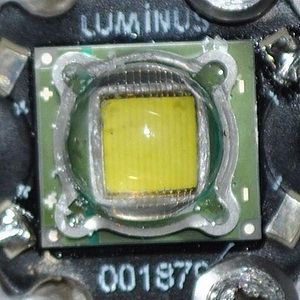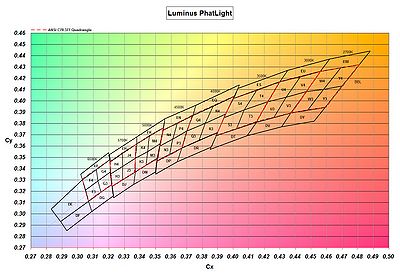Luminus

Luminus is a LED manufacturer based in Billerica, Massachusetts. They produce the SST-50 and SST-90 LEDs (SSR-50 and SSR-90 are just the LED mounted to a star). These LEDs compete with the SSC P7 and Cree MC-E, but the LED is a single emitter instead of 4 separate ones working together. The size of the emitter is similar so there is a large hotspot, but because the entire emitter lights up, SST-50 lights are less prone to a donut hole of darkness at the center of the beam.
SBT-90
The SBT-90 uses the same die as the SST-90, but it is behind a flat window instead of a dome. While the SBT-90 has less output, flashlights that use the SBT-90 will have greater throw than an equivalent with an SST-90. This LED was first used the Olight SR95 and EagleTac MX25L2. Web page, datasheet, binning.
| Bin | 3150mA (350mA/mm²) 44% |
5000mA (555mA/mm²) 64% |
9000mA (1000mA/mm²) 100% |
|---|---|---|---|
| MB | 653-700 | 950-1018 | 1485-1590 |
| NA* | 700-752 | 1018-1094 | 1590-1710 |
SST-50
The SST-50 is 2.2mm x 2.2mm (5 mm²) drawing up to 5 amps while outputting up to 1250 emitter lumens. This is a big current draw for a flashlight and batteries and produces a large amount of heat, therefore the LEDs are driven lower than maximum. Flashlights using this LED are capable of 500 lumens of output on one 18650 li-ion cell and up to 900 lumens using 2 18650's. web page, datasheet, binning.
The SST-50 is used in the ThruNite Catapult, LumaPower D-Mini VX Ultra, Olight M21 Warrior Luminus, and the Tiablo AS50.
Here are the Brightness Bins for the SST-50. Sometimes the flux bins are given as "GG" instead of "WG" but it seems to be the same thing. Note that unlike Cree, Luminus gives benchmarks at some current per mm² instead of just a current level to the LED. Bins shown below were revised in February 2011 (for reference the old bins are here).
| Bin | 1750mA (350mA/mm²) 100% |
2800mA (560mA/mm²) 160% |
5000mA (1000mA/mm²) 270% |
|---|---|---|---|
| G | 275-350 | 440-560 | 743-945 |
| H | 350-425 | 560-680 | 945-1148 |
| J* | 425-500 | 680-800 | 1148-1350 |
| K | 500-600 | 800-960 | 1350-1620 |
| L | 600-700 | 960-1120 | 1620-1890 |
SST-90
The SST-90 is 3mm x 3mm (9mm²) drawing up to 9 amps while outputting up to 2250 emitter lumens. Bins K, L, M, N, and P are subdivided into 50-lumen increments (e.g. M1, M2, and M3, where M1 would 700-750, M2 would 750-800, etc.).web page datasheet, binning.
| Bin | 3150mA (350mA/mm²) 100% |
5000mA (555mA/mm²) 155% |
9000mA (1000mA/mm²) 270% |
|---|---|---|---|
| L | 600-700 | 930-1085 | 1620-1890 |
| M | 700-850 | 1085-1318 | 1890-2295 |
| N | 850-1000 | 1318-1550 | 2295-2700 |
| P* | 1000-1200 | 1550-1860 | 2700-3240 |
| Q | 1200-1450 | 1860-2248 | 3240-3915 |
CBM-360
The CBM/CSM-360 is four SST-90 dies mounted on a single device. It is designed as a replacement for high power illumination lamps. web page
Tint Bins

Luminus uses tint bins based on ANSI White groupings, but they are expanded and subdivided. Each ANSI quadrangle is subdivided into four quadrants plus there are additional regions outside of ANSI. In product numbers, the tint bin is given towards the end, just before the last 3 digits which indicate a wavelength. Other parts of the product number give the ANSI CCT value:
| Bin | Name | Temperature |
|---|---|---|
| DL | Daylight | 6500-5000K |
| CL | Cool white | 5000-4000K |
| WT | White | 4500-3500K |
| WR | Warm white | 3500-2700K |
Luminus also assigns a CRI code where S is a CRI of 70, M is 83, and H is 92.